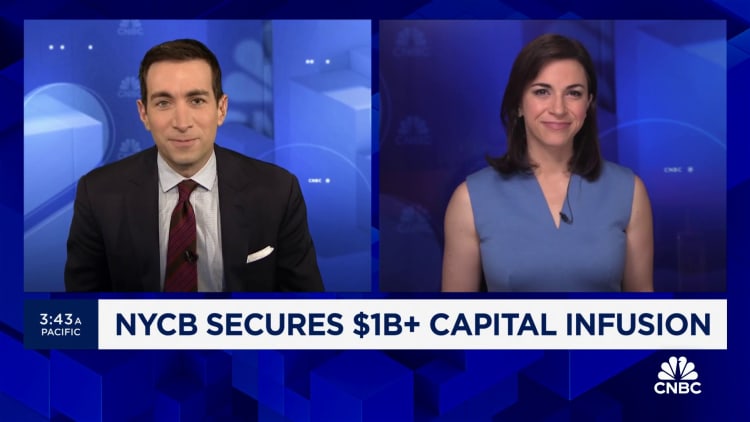CostFoto | Future Publishing | Getty Images
New York Community Bank has lost 7% of deposits over a turbulent month as customers pulled their money from the regional commercial bank.
A new capital infusion of over $1 billion takes the NYCB off the “watch list” for another potential bank failure, according to Sheila Bair, former chair of the Federal Deposit Insurance Corporation from 2006 to 2011.
“Consumers should not worry about this,” said Bair, who is also a member of the CNBC Global Financial Wellness Council and author of the “Money Tales” children’s book series.
More from Personal Finance:
Many think pensions key to achieving American Dream
How to avoid unexpected fees with payment apps
‘Ghosting’ gets more common in the job market
FDIC deposit insurance coverage generally covers $250,000 per depositor per bank per ownership category. However, it is possible to obtain higher coverage amounts by having different account structures through joint accounts and trust accounts, Bair noted.
“For regular, Main Street households, the $250,000 is more than enough,” Bair said.
More bank failures could be looming
NYCB’s woes come about one year after Silicon Valley Bank and Signature Bank collapsed, followed by First Republic in May.
More bank failures are likely looming amid recession risks, uncertain interest rate forecasts and weakness in the commercial real estate market, Bair warned in a recent editorial in The Washington Post that she co-authored with Charles Goodhart, emeritus professor at the London School of Economics.
Recent bank failures were largely caused by bank mismanagement. Yet legislation to increase accountability for those leaders has stalled on Capitol Hill, they wrote.
Consumers can take comfort in the fact that banking regulators have been working overtime since last year to review the banks and ensure they are carefully monitored, particularly if they have concentrations of risky loans or other types of activities that may cause stress, said Dennis Kelleher, president and CEO of Better Markets, a non-profit organization focused on building a more secure financial system.
“If you’re a depositor, 99% of depositors have no worries, because deposits up to $250,000 are fully insured by the FDIC,” Kelleher said.
How to check your deposit coverage
It’s important for consumers to make sure they are below the uninsured deposit limits, Bair said. To help with that, FDIC provides a tool on its website to help consumers test their coverage.
In the event of a failure, consumers who are below the insured deposit limits can generally expect continued access to their deposits, according to Bair.
“The FDIC has a perfect track record of protecting those deposits,” Bair said. “When a bank fails, in almost all situations, they provide immediate seamless access, there’s no disruption at all in the access to the bank account.”
Depositors have plenty of information to keep tabs on banks, including through financial statements, as well as call reports filed with the FDIC.
“Most regional banks are fine,” Bair said. “The problems have been primarily concentrated in rapid growth regional banks with very poor risk management, and I think that is a small minority of regional banks.”
Yet there are some fragile institutions, which makes it important to tighten up risk management incentives, she said.
Small businesses, which need to protect their cash flow and ability to conduct business, should be on heightened alert, according to Kelleher.
“Small businesses have to be thinking about how much money they’ve got in a bank that may be under stress, and whether or not they feel comfortable with the level of stress the bank is under,” Kelleher said.
Credit: Source link




